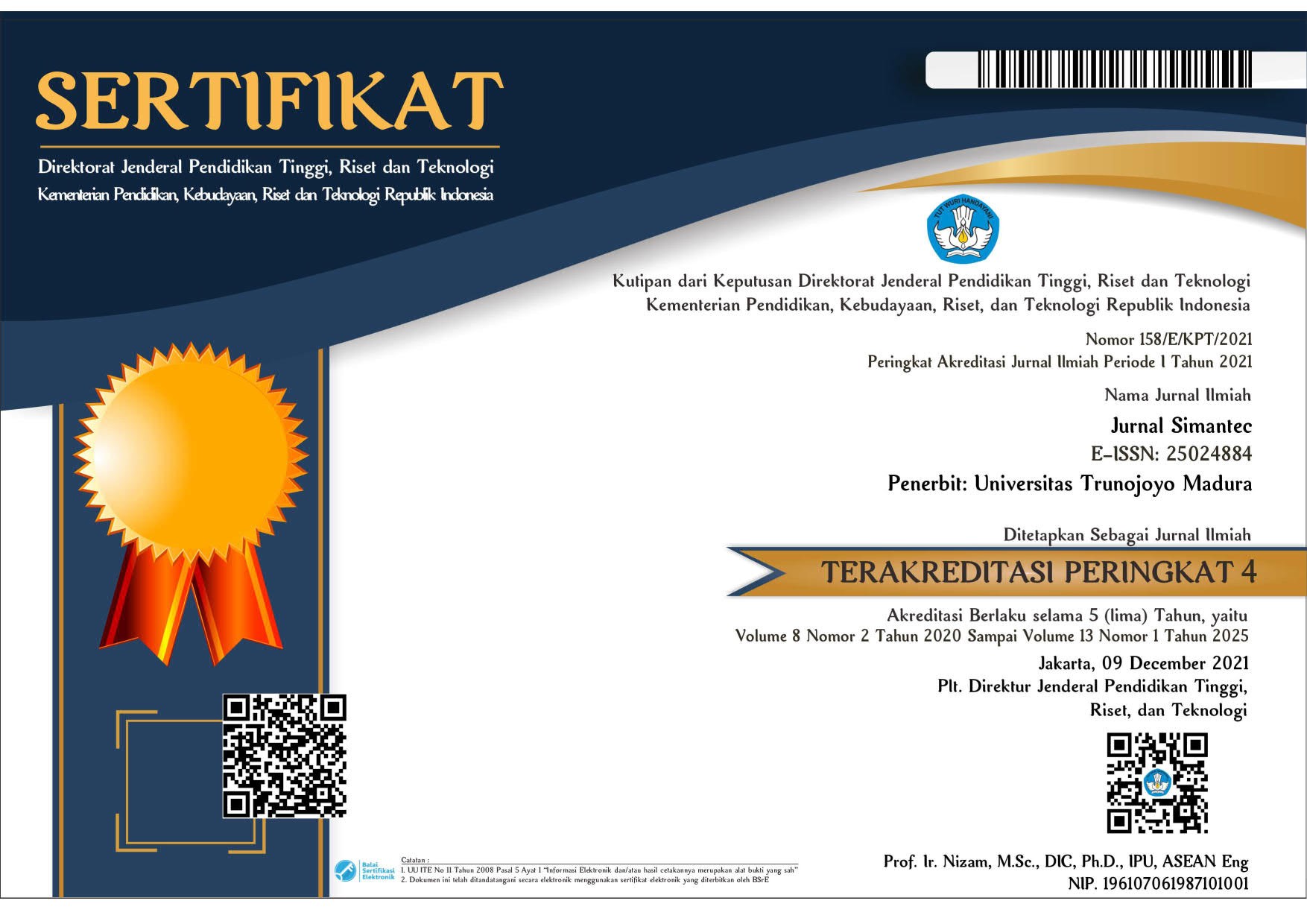Web-based decision support system for boarding house selection according to preferences in Kefamenanu (BTN) area using Tsukamoto Fuzzy Logic Method
Abstract
The problem in searching for boarding houses in the Kefamenanu (BTN) area is the many choices with different variations in price, facilities, distance, and comfort levels, making it difficult for prospective residents to determine a boarding house that suits their personal preferences. This study aims to build a web-based decision-making system that can help users choose a boarding house according to their interests quickly and accurately. The method used is the Tsukamoto Fuzzy Logic method, which is able to accommodate uncertainty and subjectivity in the assessment process of boarding house selection criteria. The system is designed with several fuzzy variables such as price, distance, facilities, and comfort, which are processed through fuzzy rules in the form of IF-THEN to produce the best boarding house recommendations. The novelty of this study lies in the application of the Tsukamoto method in the context of selecting boarding houses in Kefamenanu, which has not previously been widely developed using a fuzzy logic approach. The contribution of this study is to produce a web-based platform that is able to accelerate the process of searching for boarding houses that suit user needs, while increasing accuracy and satisfaction in decision making. The results of the study showed that the system was able to recommend boarding house options with a level of user preference matching reaching 90%, based on the results of trials on 30 respondents in the BTN Kefamenanu area.
Keywords: Web-Based Application, Fuzzy Logic, Tsukamoto Method, Boarding House Selection, Decision Support SystemFull Text:
PDFReferences
D. Yusma, N. Merlina, and N. Nurajijah, “Web-Based Boarding House Search Information System,” INTI Nusa Mandiri, vol. 15, no. 2, pp. 127–134, 2021, doi: 10.33480/inti.v15i2.1702. https://doi.org/10.33480/inti.v15i2.1702
T. Adriantama and Y. Brianorman, “Decision Support System in Selection of Student Stays (Kost) With Simple Additive Weighting (Saw) Method,” J. Digit. Teknol. Inf., vol. 4, no. 1, pp. 1–7, 2021. https://doi.org/10.32502/digital.v4i1.2645
K. K. Rekayasa et al., “Web-Based Decision Support System for Predicting Boarding House Prices for IT Telkom Purwokerto Students Using the Fuzzy Tsukamoto Method,” Data Inst. Teknol. Telkom Purwokerto, vol. 1, no. 2, pp. 77–81, 2021, [Online]. Available: http://journal.ittelkom-pwt.ac.id/index.php/dinda https://doi.org/10.20895/dinda.v1i2.202
Y. P. K. Kelen et al., “Decision support system for the selection of new prospective students using the simple additive weighted (SAW) method,” AIP Conf. Proc., vol. 2798, no. 1, 2023, doi: 10.1063/5.0154676. https://doi.org/10.1063/5.0154676
A. Firdonsyah, B. Warsito, and A. Wibowo, “Comparative Analysis of SAW and TOPSIS on Best Employee Decision Support System,” SinkrOn, vol. 7, no. 3, pp. 1067–1077, 2022, doi: 10.33395/sinkron.v7i3.11475. https://doi.org/10.33395/sinkron.v7i3.11475
S. Fadli, M. Ashari, and S. Saikin, “Decision Support System for Determining Poor Families Using the Fuzzy Tsukamoto Method,” J. Inf. Syst. Res., vol. 4, no. 1, pp. 300–308, 2022, doi: 10.47065/josh.v4i1.2305. https://doi.org/10.47065/josh.v4i1.2305
S. Agius, C. Magri, and V. Cassar, “A Cognitive Task Analysis for Developing a Clinical Decision Support System for Emergency Triage,” J. Emerg. Nurs., 2025, doi: https://doi.org/10.1016/j.jen.2025.05.013
I. A. Mitrofani, D. M. Emiris, and D. E. Koulouriotis, “An Industrial Maintenance Decision Support System based on Fuzzy Inference to Optimize Scope Definition,” Procedia Manuf., vol. 51, pp. 1538-1543, 2020, doi: https://doi.org/10.1016/j.promfg.2020.10.214
Suharjito, Diana, Yulyanto, and A. Nugroho, “Mobile Expert System Using Fuzzy Tsukamoto for Diagnosing Cattle Disease,” Procedia Comput. Sci., vol. 116, pp. 27-36, 2017, doi:https://doi.org/10.1016/j.procs.2017.10.005
P. Zandi, M. Ajalli, and N. S. Ekhtiyati, “An extended simple additive weighting decision support system with application in the food industry,” Decis. Anal. J., vol. 14, p. 100553, 2025, doi: https://doi.org/10.1016/j.dajour.2025.100553
O. U. Araz, E. Kemiklioglu, and B. Gurboga, “Modeling of the lyotropic cholesteric liquid crystal based toxic gas sensor using adaptive neuro-fuzzy inference systems,” Expert Syst. Appl., vol. 240, p. 122326, 2024, doi: https://doi.org/10.1016/j.eswa.2023.122326
M. K. Sharma, N. Dhiman, A. Sharma, and T. Kumar, “IoMT Tsukamoto Type-2 fuzzy expert system for tuberculosis and Alzheimer's disease,” Clin. eHealth, vol. 7, pp. 77-91, 2024, doi: https://doi.org/10.1016/j.ceh.2024.05.002.
A. Letsoin and A. S. Purnomo, “Development of a Decision Support System To Determine Used Motorcycle Prices Using the Web-Based Fuzzy Tsukamoto Method,” IJIS Indones. J. Inf. Syst., vol. 9, no. April 2024, pp. 60–72. https://doi.org/10.36549/ijis.v9i1.311
J. Hutahaean and J. Hutagalung, “Decision Support System for Selecting the Best Technician Using the Fuzzy Tsukamoto Method,” JURIKOM (Jurnal Ris. Komputer), vol. 9, no. 4, p. 846, 2022, doi: 10.30865/jurikom.v9i4.4519. https://doi.org/10.30865/jurikom.v9i4.4519
J. Khan et al., “Optimizing alpha-beta filter for enhanced predictions accuracy in industrial applications using Mamdani fuzzy inference system,” Alexandria Eng. J., vol. 119, pp. 598-608, 2025, doi: https://doi.org/10.1016/j.aej.2025.01.116.
DOI: https://doi.org/10.21107/simantec.v14i1.29719
Refbacks
Copyright (c) 2025 rudy chand chandra, yoseph pius kurniawan kelen, patricia gedrudis manek
Indexed By
.png)

11.png)













